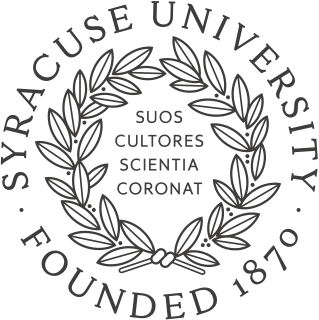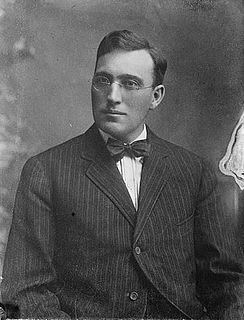
Syracuse is a city in and the county seat of Onondaga County, New York, United States. It is the fifth-most populous city in the state of New York following New York City, Buffalo, Yonkers and Rochester.

Syracuse University is a private research university in Syracuse, New York. Established in 1870 with roots in the Methodist Episcopal Church, the university has been nonsectarian since 1920. Located in the city's University Hill neighborhood, east and southeast of downtown Syracuse, the large campus features an eclectic mix of architecture, ranging from nineteenth-century Romanesque Revival to contemporary buildings.

The Syracuse Crunch are a professional ice hockey team in the American Hockey League (AHL). They play in Syracuse, New York, at the Upstate Medical University Arena. They are the primary development affiliate of the National Hockey League's Tampa Bay Lightning.

The Upstate Medical University Arena is a multi-purpose arena located in Syracuse, New York. It is part of the Oncenter Complex. Designed by Edgarton and Edgarton and built from 1949 through 1951, the structure is significant as an example of a World War I, World War II and Aroostook War commemorative and as "an early and sophisticated example of single-span thin-shell concrete roof construction." It was listed on the National Register of Historic Places in 1988. The Upstate Medical University Arena has been renovated twice, in 1994 and 2018.

Archbold Stadium was a multi-purpose stadium in Syracuse, New York. It opened in 1907 and was home to the Syracuse Orangemen football team prior to the opening of Carrier Dome in 1980.
Feiner v. New York, 340 U.S. 315 (1951), was a United States Supreme Court case involving Irving Feiner's arrest for a violation of section 722 of the New York Penal Code, "inciting a breach of the peace," as he addressed a crowd on a street.

The Toyota Coliseum, formerly the State Fair Coliseum, is an indoor arena in Geddes, New York. It hosted the Syracuse Nationals from 1946 to 1951 as well as the Syracuse Stars of the American Hockey League. It also served as a temporary home to the Syracuse Orange men's basketball team following the burning of their on-campus gymnasium, Archbold Gymnasium, in 1947 until the opening of the Onondaga County War Memorial in 1951. The arena held 7,500 people and was built in 1927. It is owned by the State of New York under the Great New York State Fair. After undergoing renovations, the seating capacity was reduced to 3,600 and is now primarily used for horse shows. Much of the previous infrastructure, including the scoreboard and announcers booth, are still in place.

WAER is a radio station in Syracuse, New York. It is located on the campus of Syracuse University, and is a part of the S. I. Newhouse School of Public Communications. The station features a jazz music and National Public Radio format, with a news, Syracuse Orange play-by-play, and music staff providing programming around the clock.

Edward Schoeneck was an American lawyer and politician. He was Lieutenant Governor of New York from 1915 to 1918.
The Syracuse Orange men's basketball program is an intercollegiate men's basketball team representing Syracuse University in Syracuse, New York. The program is classified in the Division I of the National Collegiate Athletic Association (NCAA), and the team competes in the Atlantic Coast Conference (ACC).

Frank J. "Buck" O'Neill was an American football player and coach. He served as head football coach at Colgate University, Williams College (1903), Syracuse University, and Columbia University (1920–1922), compiling a career college football coaching record of 87–45–9. O’Neill was a two-sport athlete at Williams College where he played football and ran track. He was inducted into the College Football Hall of Fame as a coach in 1951.
Charles William Peter Reynolds was an American football player and coach. He served as the head football coach at Hobart College (1909–1913), Hamilton College (1914–1916), Bucknell University (1919–1923), Syracuse University (1925–1926), and Knox College in Galesburg, Illinois (1935–1937), compiling a career college football record of 77–58–14. Reynolds died at the age of 66 on December 26, 1951 in Oneida, New York.

The Allentown Chiefs were a minor league baseball team. They played in the Class A Eastern League, and started the 1957 season in Syracuse, New York. The team was purchased by the Boston Red Sox and was moved to Allentown, Pennsylvania, mid-season on July 13, 1957, and finished the season playing at Breadon Field in Whitehall Township, just north of Allentown.

Ground Equipment Facility QRC is an FAA radar station that was part of a Cold War SAGE radar station for aircraft control and warning "from Massachusetts to southern Virginia, and as far out to sea as possible." Benton AFS was also the first operational "regional data processing center" for the GE 477L Nuclear Detection and Reporting System.

Cycling in Syracuse, New York, has been common on the roads and paths for recreation, commuting, and as a sport since the latter part of the 19th century.
Bernard Eugene Custis was an American and Canadian football player who went on to a distinguished coaching career. He is known for having been the first black professional quarterback in the modern era and first in professional Canadian football, starting for the Hamilton Tiger-Cats in 1951.
The 1951–52 NBA season was the Nationals' 3rd season in the NBA.
The 1951 Syracuse Orangemen football team represented Syracuse University in the 1951 college football season. The Orangemen were led by third-year head coach Ben Schwartzwalder and played their home games at Archbold Stadium in Syracuse, New York. Syracuse finished the season with a 5–4 record and were not invited to a bowl game.

The Ferrari 212 F1 was a Formula 1 and Formula 2 racing car designed by Aurelio Lampredi for Scuderia Ferrari in 1951.
The 1951 Boston University Terriers football team was an American football team that represented Boston University as an independent during the 1951 college football season. In its fifth season under head coach Aldo Donelli, the team compiled a 6–4 record and outscored their opponents by a total of 299 to 157. Although they finished with four losses, defeated only one opponent that was ranked at the time of the game, and defeated no opponents that finished with a winning percentage above .600 other than 7–3 William & Mary, the Terriers still managed to secure a spot on the final AP Poll, just shy of the top 15. This was largely due to two first place votes that were granted to the team, becoming only the second team to receive first place votes in the final poll with a winning percentage of .600 or worse, the first being 5–4–1 Holy Cross in 1942. The 1951 Boston team is considered by James Vautravers, a college football historian who analyzes past AP polls, to be the worst AP rated team of all time.













